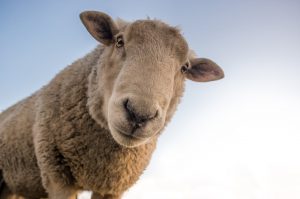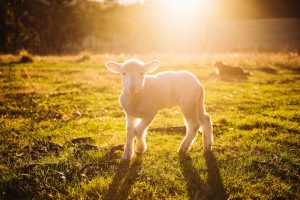It is quite likely that in your searches about large scale solar plants that you will come across some photos of sheep around the solar panels. In fact it is generally considered good practice for solar developers to consider animal grazing under the panels and a choice, that with an appropriate grazing plan, we support.

Good Practice Guidelines
The BRE National Solar Centre have published a document called Agricultural Good Practice for Solar Farms, which discusses the intertwining of grazing animals with the solar panels. Whilst larger animals such as horses and cattle are too big and strong for the solar panel supports, and pigs and goats are notorious for chewing on wires, sheep and poultry have successfully been used on solar farms.
This provides two benefits:
~ a natural way to help* maintain the grass growing under the panels
~ dual purpose for the land so it can continue in agricultural use
*grass is still highly likely to need some, albeit reduced, mechanical maintenance. Especially around the edges and the legs of the supports, as well as with any weeds and unpalatable grass that the sheep would avoid (sheep don’t eat all grass).
Will Enso Energy use Sheep?
Within the EIA Scoping Opinion documents that Enso Energy submitted to Mid Suffolk District Council they stated:
the continuation of agricultural activity through low intensity sheep grazing
page 8, section 1.1 of Scoping Request
2.2m high security deer type fencing and gates to enclose the parameters of the Site and
page 11, section 2.1 of Scoping Request
potentially allow sheep to graze securely
There are no other mentions of sheep in the document. None.
There is no grazing plan. There is no movement plan to state how sheep will be herded from one field to the next. There are no vehicles counted in the transport section for the transport of sheep in and out of the site, nor for the shepherd who would be needed to attend on a daily basis for welfare purposes.
Of equal worry is that there is no supporting infrastructure in the area to support sheep. No buildings for overwintering. No lambing sheds (although some hardier breeds can lamb outdoors). And nothing in the Enso Energy proposals to show they would be building any.
The Enso Energy proposal also paints a picture of wildflowers with its claim of “planting wildflower grassland around the arrays”, but the BRE document referenced above states:
Avoiding grazing in either the spring or summer will favour early or late flowering species
BRE Agricultural Good Practice Guidance for Solar Farms
So with the sheep needing overwintering in buildings from late autumn and winter, and advice to avoid grazing in either the spring or summer, by our calculations there are only a few weeks of the year when best practice would even allow them to be on the fields.
Also of great concern to us is that the Enso Energy proposal includes tracking solar panels. These panels tilt as they follow the sun’s angle across the sky, and the moving parts on the racking that supports the panels provide an entrapment hazard to the animals.
Well how about on the EDF site?
Within the glossy EDF brochure that they sent out to the public it states:
there will be ample room underneath and between the panels for seasonal grazing of sheep.
EDF Tye Lane Solar Farm Brochure
Sounds great. And of the two proposals, between Enso Energy and EDF, sheep on the EDF site was certainly more likely. The solar panels would be static or fixed panels, so there would be no hazard from moving parts on the solar arrays. There is also a large agricultural building near the site entrance which, with the surrounding arable fields not in use for arable production, could potentially be converted to support a small sheep flock.
However, EDF have admitted to the CARE Suffolk team that “sheep are a non starter”. So that’s the end of that.
Instead, EDF will use mechanical maintenance to keep the grass cut. This will be in the form of a tractor and 3m cutting deck. And the grass cuttings will be left in place to rot. To cut the 65ha of panelled area (they’ve not mentioned how the rest of the full 82ha site will be maintained), they estimate it will take 48 working hours to complete. Over an 8 hour day that is 6 working days. We’re not sure how this fits into their claim that site maintenance will be a “man with a van once or twice a month” when that allowance has been taken up before the grass has even been cut.
Conclusion
In all honesty, whilst we love the idea of sheep, it seems the mention of sheep is merely that. A casual mention.
EDF have admitted there will be no sheep, and there is nothing to give any realistic weight to sheep being used on the Enso Energy site, and even if there were, the proposal of tracking panels would be a hazardous mix.
So we’re very sorry to tell you this, but there won’t be any sheep frolicking around the solar panels. For now, if you’d like to see some sheep they’ll be grazing on a open field, where the grass gets its full dose of sunshine.

Have EDF given a reason for not having sheep grazing? I suspect they will only cut 2 or 3 times a year. Cutting the grass and leaving the cuttings in place will not benefit wild flowers.
Unfortunately they haven’t given a reason. They have just said that the sheep are a “non-starter” so there won’t be any. And you are correct about the wildflowers, leaving the cuttings in place is not beneficial to them. Cutting them is also not beneficial to any of the insects that they are likely attempting to attract with them either.
I would have thought it’s better without sheep, to be honest. So long as they don’t put gravel down, or spray it with glyphosate, they’ll end up with a semi-wild environment where insect, ground-nesting birds (such as skylarks), and small mammals can dwell largely undisturbed by the generation of clean power above their heads.
At the moment the developers have not confirmed anything about not putting gravel down in the solar array areas. Enso have confirmed they will still use chemicals but have given no details on this. With regards to the skylarks the Solar Trade Industry themselves state that skylarks will not nest under solar arrays.
Glyphosate is often sprayed to kill off weeds before planting crops, so is not necessarily a cause for concern. What matters is what is planted afterwards. If it is wild flowers this would create a valuable resource for wildlife.